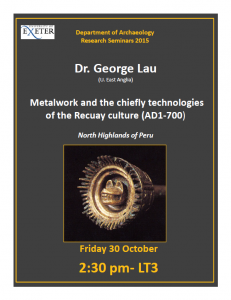 Our visiting speaker last Friday was Dr. George Lau of the University of East Anglia. He delivered an artefact rich presentation entitled “Metalwork and the Chiefly Technologies of the Recuay Culture (AD1-700), North Highlands of Peru”.
Our visiting speaker last Friday was Dr. George Lau of the University of East Anglia. He delivered an artefact rich presentation entitled “Metalwork and the Chiefly Technologies of the Recuay Culture (AD1-700), North Highlands of Peru”.
Dr. Lau first introduced the Recuay culture in the context of its environment and its contemporaries. The highland landscape was particularly well suited to camelid herding and tuber agriculture. The culture and its contemporaries are in a region known for their fantastically detailed pottery showing symbolism and social hierarchy, which links aspects of society such as ancestor veneration and warrior leaders.
Metalwork
Metalwork from the Recuay culture began to be common in 200-300AD in the form of weapons and personal adornment. Weapons were typically large mace-heads that could be attached to poles, and the personal adornment included pins and bells.
Pins make up the majority of the discovered metalwork. These long metal objects, gilded in copper and occasionally plated or inlaid with gold, are often depicted in pottery, shown worn at the shoulder with the pin heads pointing forward. The heads are usually fantastically decorated, often featuring iconic imagery such as felines, human heads and owls, to give a few examples. Dr. Lau suggested that these might represent divinities, or a totem or clan association. These ‘usual suspects’ are also often seen on ceramics and in the decoration of architecture. Dr. Lau concluded that these metal items could have been by the elites in acts of social distinction.
Questions from the audience focused particularly on the nature of the symbolic beings represented and the origin and production of the metals. We thank Dr. Lau for his talk, particularly the beautiful imagery of artefacts in his presentation. If you would like to read more about the Recuay culture, Dr. Lau’s book can be found here or you can find out more about his research here.
Written by Emily Johnson
